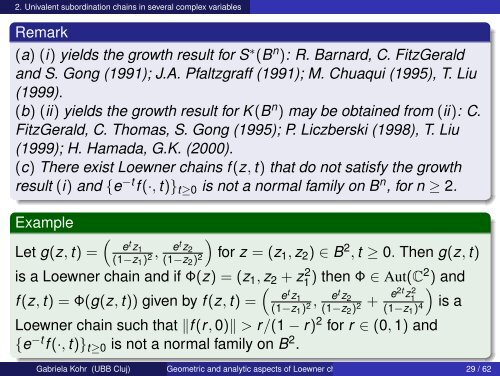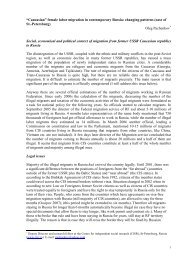Gabriela Kohr
Gabriela Kohr
Gabriela Kohr
Create successful ePaper yourself
Turn your PDF publications into a flip-book with our unique Google optimized e-Paper software.
2. Univalent subordination chains in several complex variables<br />
Remark<br />
(a) (i) yields the growth result for S ∗ (B n ): R. Barnard, C. FitzGerald<br />
and S. Gong (1991); J.A. Pfaltzgraff (1991); M. Chuaqui (1995), T. Liu<br />
(1999).<br />
(b) (ii) yields the growth result for K (B n ) may be obtained from (ii): C.<br />
FitzGerald, C. Thomas, S. Gong (1995); P. Liczberski (1998), T. Liu<br />
(1999); H. Hamada, G.K. (2000).<br />
(c) There exist Loewner chains f (z, t) that do not satisfy the growth<br />
result (i) and {e −t f (·, t)}t≥0 is not a normal family on B n , for n ≥ 2.<br />
Example<br />
Let g(z, t) =<br />
<br />
et z1<br />
(1−z1) 2 e<br />
,<br />
t z2<br />
(1−z2) 2<br />
<br />
for z = (z1, z2) ∈ B2 , t ≥ 0. Then g(z, t)<br />
is a Loewner chain and if Φ(z) = (z1, z2 + z2 1 ) then Φ ∈ Aut(C2 ) and<br />
<br />
f (z, t) = Φ(g(z, t)) given by f (z, t) =<br />
is a<br />
<br />
et z1<br />
(1−z1) 2 e<br />
,<br />
t z2<br />
(1−z2) 2 + e2t z2 1<br />
(1−z1) 4<br />
Loewner chain such that f (r, 0) > r/(1 − r) 2 for r ∈ (0, 1) and<br />
{e−tf (·, t)}t≥0 is not a normal family on B2 .<br />
<strong>Gabriela</strong> <strong>Kohr</strong> (UBB Cluj) Geometric and analytic aspects of Loewner chains 29 / 62

















